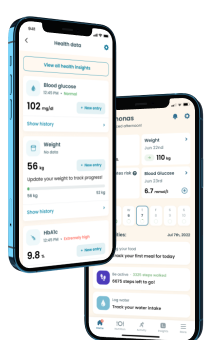Spotting the Warning Signs of Diabetes in Women

Diabetes mellitus can affect both men and women. While men are more likely to be diagnosed with type 2 diabetes, this condition often causes more serious health problems for women.
Approximately 15 million women in the U.S. have diabetes, which is about 1 in every 9 adult women. Besides the distressing symptoms of diabetes, this disease can put women at a higher risk of multiple complications, such as heart disease, blindness, and depression.
For this reason, spotting the warning signs of diabetes in women is crucial. Although there’s no cure for this condition, women can manage diabetes successfully, provided they catch the early signs before they lead to unwanted complications. This article dives into the diabetes symptoms that women should look for and how they can tackle the associated risk factors.
Signs and Symptoms of Diabetes in Women
Men and women with diabetes will likely experience many of the same symptoms. However, several diabetes symptoms are unique to women. Getting familiar with both groups of symptoms can help you identify diabetes early on and avoid potentially life-threatening complications.
Yeast infections
High blood sugar levels create the ideal breeding ground for fungus. The more blood glucose there is, the more yeast can multiply. The overgrowth of the Candida fungus can lead to yeast infections.
The symptoms of vaginal yeast infections include vaginal itching and discharge, soreness, and painful sex. Oral yeast infections are characterized by a white coating inside the mouth or on the tongue. They can cause difficulties in eating and swallowing.
Women who notice frequent oral and vaginal infections should see a doctor for a blood test to check their blood glucose levels immediately. Once they manage their blood sugar, yeast infections should significantly decrease in frequency.
Urinary tract infections (UTIs)
Most women will likely get a UTI in their lifetime. Still, women with diabetes are at an increased risk of this infection. Diabetes is a risk factor for UTIs since it reduces the body’s ability to fight bacterial and fungal infections. Plus, too much sugar in the urine creates ideal conditions for bacterial growth.
A UTI develops when bacteria enter a woman’s urinary tract, resulting in painful urination and cloudy or bloody urine. If women don’t treat these symptoms promptly, they might lead to kidney disease.
Polycystic ovary syndrome (PCOS)
Experts are still not 100% sure what causes PCOS. They have determined several risk factors, including a family history of PCOS. This condition is also associated with insulin resistance, which can be a cause or a symptom of PCOS.
Insulin resistance is also a hallmark of prediabetes and type 2 diabetes. People with insulin resistance fail to respond correctly to the insulin produced by beta cells, the pancreas’s insulin-producing cells. As a result, these cells will create more insulin to persuade the muscle and fat cells to take up glucose and the liver to keep storing it.
Over time, the body’s cells will wear out and fail to produce enough insulin to overcome the resistance, resulting in higher blood glucose levels.
The most common signs and symptoms of PCOS include irregular periods, acne, weight gain, and infertility.
Decrease in sex drive
Diabetes can lower women’s interest in sex and the ability to enjoy it.
High blood sugar levels cause fatty deposits inside blood vessels, impeding blood flow. When this issue affects the genital area, it decreases women’s sexual responses. In addition, nerve damage caused by diabetes can result in vaginal dryness, making intercourse uncomfortable or even painful.
Diabetic neuropathy may also affect sensation in the vaginal area, leading to symptoms like vaginal dryness.
Frequent urination
Frequent urination is the first among the signs and symptoms both men and women with diabetes share. It occurs when the body instinctively tries to eliminate the excess sugar coursing through the bloodstream. If you start urinating more frequently for no apparent reason, it might be time to talk to your doctor and do a blood test.
Increased thirst
Besides excess sugar, urinating more frequently expels water from the tissues. As a result, women can become dehydrated and constantly feel thirsty. To make matters worse, people often quench their thirst with sugary drinks, thus further adding to their blood sugar levels.
Weight loss
Diabetes is a common reason for unexplained weight loss. Since cells can’t get enough energy from sugar, they resort to burning the body’s fat and muscle for energy, resulting in weight loss. The weight loss can be rather dramatic, with some women losing up to 10% of their body weight in less than six months.
Fatigue
You could feel exhausted for many reasons, from the more obvious ones like lack of sleep to your diet and stress levels. However, if you feel inexplicably exhausted, diabetes might have something to do with it. After all, this condition impedes your body from effectively using its primary source of energy – blood sugar.
Blurred vision
Blurred vision is among the most ignored diabetes symptoms in women. It results from high blood sugar leading to fluid forming in the eye’s lens. This, in turn, can damage the tiny blood vessels in the eyes, which manifests as blurry vision.
Numbness in the extremities
According to the American Diabetes Association (ADA), more than half of people with type 2 diabetes experience numbness or tingling sensations in their arms, legs, and feet. This numbness results from high blood sugar reducing blood flow to the extremities and gradually damaging the blood vessels and nerves.
Slow-healing wounds
High cholesterol and high blood pressure often accompany diabetes. The plaque buildup from these conditions can narrow blood vessels, which leads to reduced blood flow and slow healing.
Increased blood sugar levels can also weaken the T cells that make up the body’s immune system, thus delaying its response to wounds.



Skin infections
Yeast infections caused by increased blood sugar levels can also occur on the skin. These can, in turn, lead to skin infections that look like itchy rashes of moist areas surrounded by tiny blisters. Itchiness can also come from poor circulation. The legs will typically be the itchiest area if that’s the case.
Dark skin patches
Darkening of the skin under your armpits, around the nape of the neck, and in the groin area can indicate insulin resistance, a precursor to diabetes.
Fruity breath
A sweet, fruity odor to your breath can be a sign of diabetic ketoacidosis (DKA). DKA is one of the most severe diabetes complications that can be fatal when left untreated. DKA is more common among women with type 1 diabetes. Still, even women with type 2 diabetes diagnosis can develop DKA.
This condition develops when your body doesn’t produce enough insulin, so it breaks down fat as fuel, resulting in a buildup of acids in the bloodstream.
Complications of Diabetes in Women
Women who develop diabetes are at a higher risk of serious health problems that can significantly impact their quality of life. The most common diabetes complications in women include:
- Coronary heart disease that leads to a heart attack
- Digestive and kidney diseases
- Nerve damage that can lead to loss of feeling in the affected limb
- Eye damage that can lead to diabetic retinopathy and blindness
- Foot damage that can result in amputation
- Depression
- Eating disorders
Complications of Gestational Diabetes

Gestational diabetes is a type of diabetes that occurs when women have increased blood sugar levels during pregnancy. According to the Centers for Disease Control and Prevention (CDC), gestational diabetes affects up to 10% of pregnancies yearly.
Most women with gestational diabetes have a normal pregnancy and deliver a healthy baby. However, uncontrolled blood sugar levels can cause several problems for the mother and the baby. For this reason, women often take medicine or insulin shots to keep themselves and their babies healthy.
Complications for the baby
Gestational diabetes increases the risk of several complications for the baby whose mother develops this condition. In the worst-case scenario, this condition can have a fatal outcome for the baby before or shortly after birth.
Excess growth
Extra glucose can trigger the baby’s pancreas to produce additional insulin, causing the baby to grow too large. The baby’s size can lead to a difficult birth and the necessity to perform a C-section.
Low blood sugar
Newborn babies can have low blood sugar levels at birth due to the extra insulin their pancreas creates. This can, in turn, put them at a higher risk for breathing problems.
Type 2 diabetes
Gestational diabetes in mothers is one of the significant risk factors for the baby developing type 2 diabetes later in life. The same goes for obesity.
Complications for the mother
Gestational diabetes can also cause a few health complications for the mother. For starters, women who have gestational diabetes in one pregnancy will likely have it again the next time they get pregnant. This condition can lead to preeclampsia, a high-blood pressure disorder with multiple health implications.
How Diabetes Affects Women Differently
Diabetes rates might be slightly higher in men, but this condition affects women differently.
Firstly, women with diabetes more than double their chances of developing heart disease. On top of that, the U.S. healthcare system often provides women with less aggressive treatments for cardiovascular risk factors. As a result, women have significantly worse outcomes after a heart attack.
Also, women’s hormone cycles can change their responses to insulin. So, they might need more careful blood sugar management throughout their lives. This approach is critical during extreme hormonal shifts, such as pregnancy and menopause.
Preventing Diabetes in Women

Unfortunately, as an autoimmune disease, type 1 diabetes can’t be prevented. But, specific lifestyle changes can prevent type 2 and gestational diabetes.
Since genetics plays a huge role in developing diabetes, it helps to find out about your family history. If you have a family member with diabetes, it would be prudent to monitor your blood glucose even more closely.
Here are some actionable steps to help prevent diabetes or reduce its symptoms.
Try to lose the extra weight
According to a 2021 study, losing as little as 5% of your total body weight can help lower your risk of diabetes if you’re overweight or have prediabetes. Consider consulting with your health provider to determine a healthy weight for your body and strive to reach that goal in the long run.
Remember that you can only accomplish this goal by making healthier lifestyle choices. After all, research is yet to prove the long-term benefits of fad diets, such as paleo or keto.
Adopt a healthier diet
Even if you aren’t overweight, healthy eating can go a long way toward preventing diabetes. When it comes to diabetes prevention, a healthy diet pertains to the following:
- Reducing the total carb intake
- Minimizing the intake of highly processed foods
- Eating plant-based foods
- Consuming high-fiber foods
- Eating healthy fats
- Reducing portion sizes
However, it’s important to note that there’s no one-size-fits-all solution regarding a healthy diet. Every woman’s body will respond differently to specific foods. Therefore, you should take an individualized approach that includes receiving a personalized meal plan according to your needs.
Exercise regularly
Regular physical activity is crucial to maintaining a moderate weight and keeping diabetes at bay. With that in mind, women should aim to do the following:
- Get at least 30 minutes of aerobic activity on most days of the week or 150 minutes weekly
- Do resistance training at least two times a week to increase their balance, strength, and ability to maintain a healthy lifestyle
- Cut back on sedentary behaviors and break up long bouts of inactivity.
Better Choices, Better Life

Diabetes is one of the most serious health conditions as it affects the entire body, and its mismanagement can lead to severe consequences. Although this condition can affect all genders, women can exhibit unique symptoms not seen in other patients. Spotting the signs of diabetes in women early on can help them keep it under control and avoid complications.
Even better, women can take specific steps to prevent the disease from progressing or appearing altogether. One of the essential steps in diabetes prevention is a healthy and balanced diet.Since every woman responds to specific foods differently, you can benefit from a customized meal plan. Our Klinio app provides a personalized diabetes program to help you start managing your condition effectively. This handy app can be your virtual guide and caregiver, helping you make vital lifestyle changes and stick to them long-term.
Take a quiz and get your diabetes-management plan today!








